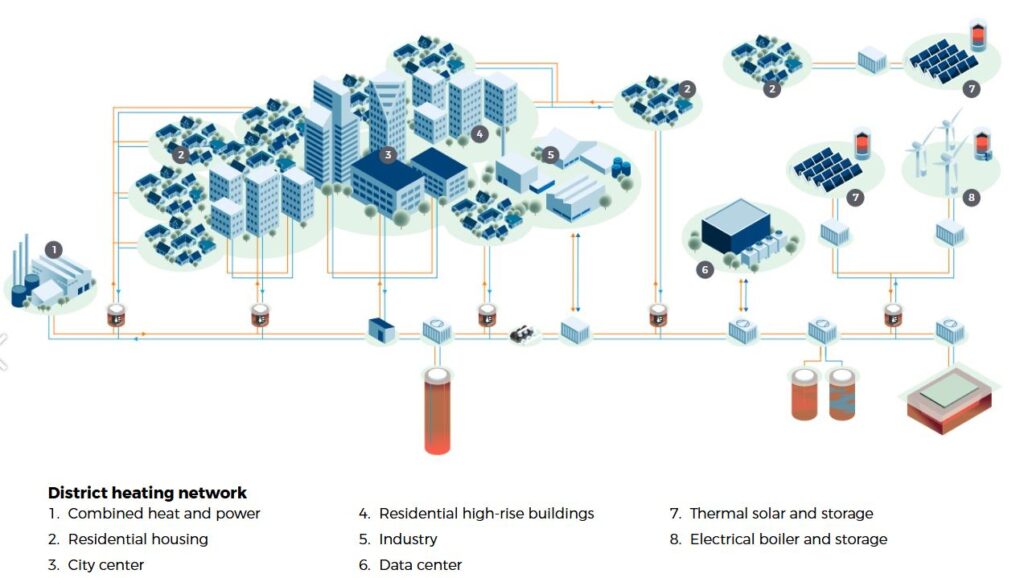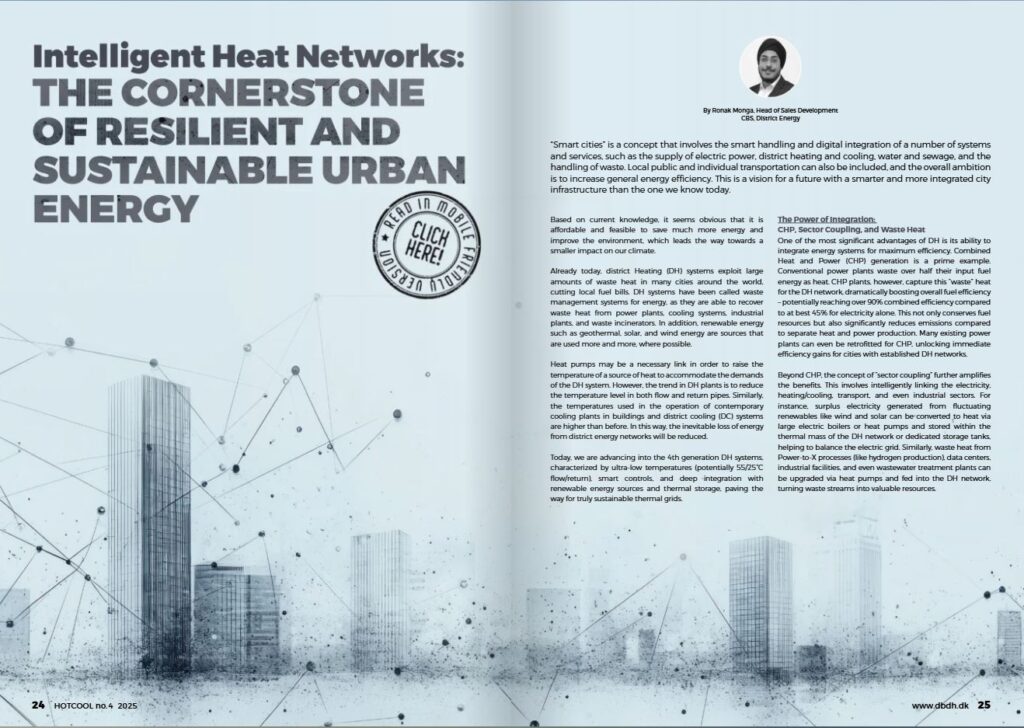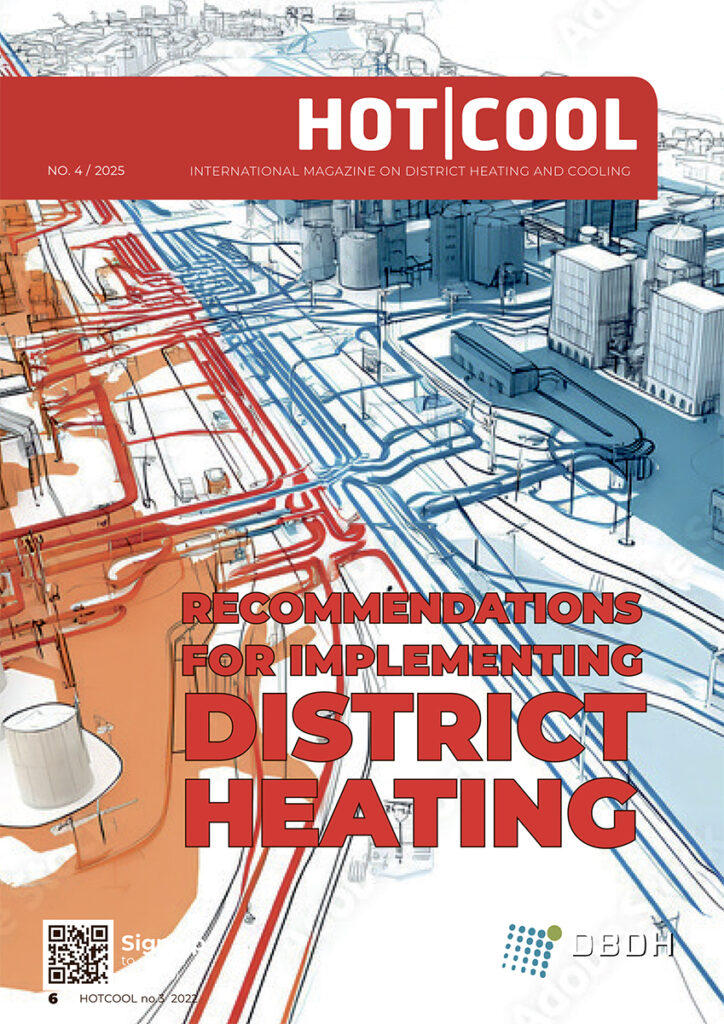“Smart cities” is a concept that involves the smart handling and digital integration of a number of systems and services, such as the supply of electric power, district heating and cooling, water and sewage, and the handling of waste. Local public and individual transportation can also be included, and the overall ambition is to increase general energy efficiency. This is a vision for a future with a smarter and more integrated city infrastructure than the one we know today.
By Ronak Monga, Head of Sales Development CBS, District Energy
Published in Hot Cool, edition no. 4/2025 | ISSN 0904 9681 |
Based on current knowledge, it seems obvious that it is affordable and feasible to save much more energy and improve the environment, which leads the way towards a smaller impact on our climate.
Already today, District Heating systems exploit large amounts of waste heat in many cities around the world, cutting local fuel bills. District heating systems have been called waste management systems for energy, as they are able to recover waste heat from power plants, cooling systems, industrial plants, and waste incinerators. In addition, renewable energy such as geothermal, solar, and wind energy are sources that are used more and more, where possible.
Heat pumps may be a necessary link in order to raise the temperature of a source of heat to accommodate the demands of the DH system. However, the trend in DH plants is to reduce the temperature level in both flow and return pipes. Similarly, the temperatures used in the operation of contemporary cooling plants in buildings and DC systems are higher than before. In this way, the inevitable loss of energy from DE networks will be reduced.
Today, we are advancing into the 4th generation, characterized by ultra-low temperatures (potentially 55/25°C flow/return), smart controls, and deep integration with renewable energy sources and thermal storage, paving the way for truly sustainable thermal grids.
The Power of Integration: CHP, Sector Coupling, and Waste Heat
One of the most significant advantages of DH is its ability to integrate energy systems for maximum efficiency. Combined Heat and Power (CHP) generation is a prime example. Conventional power plants typically waste over half their input fuel energy as heat. CHP plants, however, capture this “waste” heat for the DH network, dramatically boosting overall fuel efficiency – potentially reaching over 90% combined efficiency compared to perhaps 45% for electricity alone.
This not only conserves fuel resources but also significantly reduces emissions compared to separate heat and power production. Many existing power plants can even be retrofitted for CHP, unlocking immediate efficiency gains for cities with established DH networks.
Beyond CHP, the concept of “sector coupling” further amplifies the benefits. This involves intelligently linking the electricity, heating/cooling, transport, and even industrial sectors. For instance, surplus electricity generated from fluctuating renewables like wind and solar can be converted to heat via large electric boilers or heat pumps and stored within the thermal mass of the DH network or dedicated storage tanks, helping to balance the electric grid.
Similarly, waste heat from Power-to-X processes (like hydrogen production), data centers, industrial facilities, and even wastewater treatment plants can be upgraded via heat pumps and fed into the DH network, turning waste streams into valuable resources.
Optimizing the Network: Low Temperatures, Delta T, and Smart Control
Efficiency in DH isn’t just about the heat source; it’s also critically dependent on the network’s design and operation. Lowering the operating temperatures in the network (low-temperature district heating – LTDH) is a key trend. Lower temperatures reduce heat losses from the distribution pipes, improve the efficiency of heat sources like condensing boilers, solar thermal, and heat pumps, and allow for the easier integration of low-grade waste heat sources.
Crucial to efficient operation is maximizing the temperature difference (Delta T or ΔT) between the supply water flowing out to consumers and the return water coming back. A higher ΔT means that consumers extract more heat from the water, allowing the same amount of energy to be delivered with a lower flow rate.
This is vital because reducing the flow rate significantly cuts the energy needed for pumping – according to the affinity laws, pump power is proportional to the cube of the flow rate. Even a small increase in ΔT can lead to substantial pumping energy savings and allow for smaller pipe dimensions, reducing capital costs and heat loss. Achieving consistently high ΔT requires well-designed building installations and incentives for consumers to optimize their systems.
Modern networks also benefit from advanced control systems. Transmission networks, often operating at higher pressures and temperatures, transport heat over long distances from major generation sources to substations. Distribution networks then deliver the heat at lower pressures and temperatures to end consumers. Hydraulic separation via heat exchangers is often used between these levels or at consumer connections.
Furthermore, intelligent solutions like decentralized pressure boosting zones (e.g., Grundfos iGRID) can optimize pressure across vast networks, reducing overall pressure requirements, saving pumping energy, extending network life, and facilitating the expansion to areas previously difficult to reach or the implementation of lower temperature zones within a larger high-temperature system.
The Danish Leadership: A Blueprint for Success
Denmark is a global leader in district heating, with approximately 64% of Danish homes connected to DH networks. This widespread adoption is built on decades of strategic energy planning, technological innovation, and a cooperative model often involving consumer-owned or municipally-owned utilities operating on a non-profit basis.
The TVIS system, connecting four major towns (Vejle, Fredericia, Kolding, Middelfart) in the Triangle Region, exemplifies the benefits of scale and integration. This regional transmission network allows multiple local DH companies to utilize large amounts of surplus heat from sources like the Skærbæk CHP plant, a waste-to-energy facility, and the Shell refinery.
By interconnecting these sources and distribution areas, TVIS ensures efficient use of otherwise wasted heat, drastically reducing reliance on fossil-fuel peak boilers and providing reliable, economical, and environmentally friendly heating for over 55,000 consumers. Annually, less than 1% of the heat comes from fossil-fuel boilers, showcasing the system’s effectiveness. This model highlights how collaboration and intelligent network design can maximize resource utilization across an entire region.
The Future is Integrated: Towards Smart Thermal Grids
A sustainable energy system is a smarter, more unified and integrated system
Looking ahead, district heating is poised to become even smarter and more integrated within future energy systems. The 4th and emerging 5th generation DH concepts focus on:
- Deep Decarbonization: Rapidly phasing out remaining fossil fuels and maximizing the use of diverse renewable sources like geothermal, large-scale solar thermal (often with seasonal storage), biomass/gas, and heat pumps powered by renewable electricity.
- Enhanced Efficiency: Continued focus on lowering network temperatures, optimizing ΔT, improving building insulation, and recovering low-grade waste heat from numerous urban sources.
- Digitalization: Leveraging remote control capability, machine learning, and IoT sensors for real-time monitoring, predictive analytics, and optimized control of heat production, distribution, and consumption.
- Demand-Driven Control: Systems dynamically adjust flow and temperature based on actual consumer demand and network conditions rather than operating at fixed setpoints.
- Flexibility and Storage: Integrating thermal storage (daily or seasonal) and Power-to-Heat technologies to provide flexibility to the energy system, balance variable renewable generation, and store energy efficiently.
- Circular Economy: Maximizing waste heat recovery from industries, data centers, and potentially even unexpected sources like metro systems or supermarkets, embedding DH within a circular resource flow.
- Hybrid Systems: Closer integration with district cooling networks and other energy carriers, potentially enabling bidirectional energy flows where buildings can act as ‘prosumers’.
Conclusion: A Foundation for Sustainable Cities
The transition towards sustainable, smart cities is inextricably linked to how we manage energy, particularly heating and cooling. District energy systems, especially modern, 4th-generation district heating, stand out as a cornerstone technology for achieving deep decarbonization, enhancing energy efficiency, and improving urban living quality.
By embracing low operating temperatures, integrating diverse renewable and surplus heat sources, leveraging the power of sector coupling, and adopting intelligent digital control strategies, district heating transforms from a simple heat delivery mechanism into a dynamic, flexible, and highly efficient smart energy network. It allows cities to move away from inefficient, polluting individual systems towards a collective, optimized solution that reduces emissions, improves air quality, and offers economic benefits to consumers.
For further information, please contact: Ronak Monga at rmonga@grundfos.com
“Intelligent Heat Networks: The cornerstone of Resilient and Sustainable Urban Energy” was published in Hot Cool, edition no. 4/2025. You can download the article here:
Did you find this article useful?
Subscribe to the HOT|COOL newsletters for free and get insightful articles on a variety of topics delivered to your inbox twice a month!




